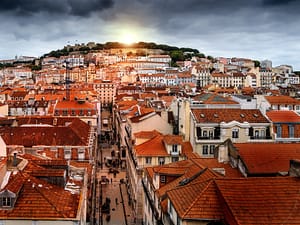Lisbon is built on seven hills. The capital of Portugal, Lisbon (Portuguese: Lisboa) has experienced a renaissance in recent years, with a contemporary culture that is alive and thriving and making its mark in today’s Europe. Perched on the edge of the Atlantic Ocean, Lisbon is one of the rare Western European cities that faces the ocean and uses water as an element that defines the city. Lisbon enchants travelers with its white-bleached limestone buildings, intimate alleyways, and an easy-going charm that makes it a popular year-round destination. Among all the metropolises in Europe, here are the warmest winters on the continent, with average temperatures around 15°C (59°F) during the day and 9°C (48°F) at night in the period from December to February. Snow and frost are very rare. The typical summer season lasts about six months, from May to October, with an average temperature of 25°C (77°F) during the day and 16°C (61°F) at night. Although, sometimes in November, March and April there are temperatures above 20°C (68.0°F) with an average temperature of 18.5°C (65°F) during the day and 11.2°C (52.2°F) at night. Rain occurs mainly in winter and the summer is very dry. Lisbon is very close to the ocean, which brings windy and fast-changing weather, so you’d better bring extra outerwear or an umbrella with you, at least in winter, spring and autumn.
About
“By day Lisbon has a naive theatrical quality that enchants and captivates, but by night it is a fairy-tale city, descending over lighted terraces to the sea, like a woman in festive garments going down to meet her dark lover.” - Erich Maria Remarque

